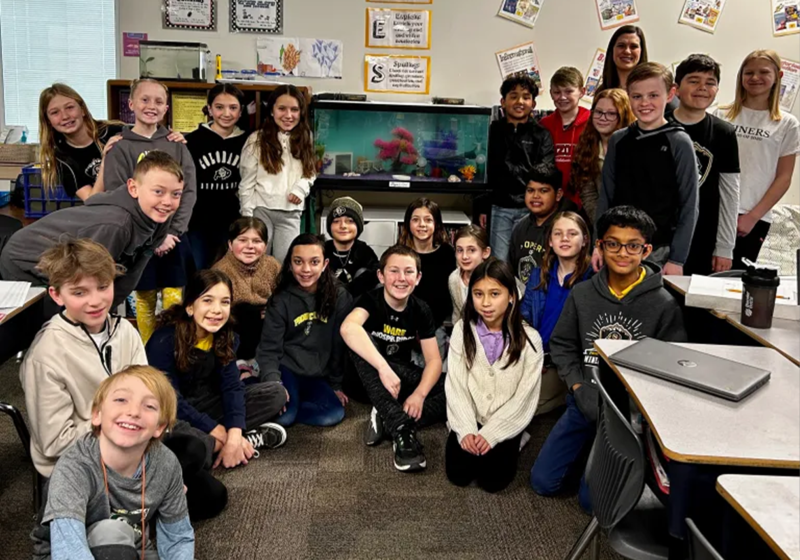By: Amy G. Partain
PRA Communications Manager
Curious black eyes peer out from the large aquatic tank in the classroom of Melanie Lostroh, the 5th grade reading teacher at Prospect Ridge Academy. Opal and Onyx, Lostroh’s pet axolotls, seem to smile at the classroom activity, inviting connection with the students.
“Axolotls are often called water puppies,” Lostroh said. “They are kind of silly creatures and can be very engaging. They are mostly nocturnal but sometimes they’ll perch on the rocks and stand up and look around. At times it can be distracting but the benefits outweigh the negatives.”
This is Opal’s and Onyx’s first year at PRA and they have become a hit with not only the 5th grade students, but other classes in the elementary and middle school as well. The axolotls have created more interest than Norbert, the beta fish, that lived in Lostroh’s classroom for the past few years.
While aquatic salamanders may not seem like an obvious choice for a reading classroom, the axolotls tie into 5th grade social studies curriculum as the students learn about the ancient Aztecs. In Aztec mythology, the axolotl was believed to be the aquatic equivalent of the god, Xolotl. In Core Knowledge curriculum, topics are learned across the academic curriculum making the axolotls the perfect pet for a 5th grade classroom.
Lostroh said that students also learn more than academics in the classroom. Each week one of Lostroh’s students serves as zoo keeper and has a chance to feed the axolotls and help care for the tank, which teaches responsibility. Most of the students are familiar with axolotls since they are a part of the popular game Minecraft. Now Lostroh’s classroom is filled with axolotl art created by her students.
“Reading can often be a subdued classroom and the axolotls spark creativity in the students,” Lostroh said, motioning to her bulletin board full of axolotl drawings created by her students.
Nothing about Lostroh’s journey with the axolotls has been planned. In the spring, axolotls owned by a friend of the Lostroh family had babies—300 of them. When the friend was trying to find homes for the babies, Lostroh decided to take a look.
“We have a 125-gallon tank with African cichlids at home, so my husband and I decided that the axolotls would need to live in my classroom,” Lostroh said. “I had intended to just get one, but when I went over and looked at the babies, I took two.”
Lostroh named them Onyx and Amethyst, and they quickly became favorite classroom fixtures for her fifth grade math students.
Taking two was risky since it is impossible to tell the gender of the axolotls until they are much older. Before that day had arrived for Onyx and Amethyst, Lostroh discovered eggs in the tank. This was problematic for a couple of reasons. First, the two axolotls were from the same line and inbreeding results in issues for domestic axolotls. Second, the parents were not even a year old yet, which also can cause complications.
Lostroh immediately removed Amethyst, the male. Dr. Marcus Cohen, middle school science teacher, took Amethyst and renamed him Alexander. Lostroh went back to her friend and brought another female, Opal, into the classroom so that Onyx wouldn’t be alone. Lostroh also culled the eggs, as is considered responsible when the parents are from the same line. Two weeks later, Lostroh found nine eggs remaining in the tank.
“By then they looked like little axolotls and I couldn’t bring myself to cull them,” Lostroh said. “I decided, let’s give it a try and see what happens.”
Eight of the nine eggs hatched. Five of the babies survived for a few weeks, but at the time of writing, the class has three surviving babies. Caring for the babies has been a labor of love for Lostroh and Cohen. Axolotl babies need 24-hour access to food and eat only live food. Cohen has been hatching baby brine shrimp for Lostroh to feed them. She visits her classroom on weekends and school holidays to keep their feeding schedule.
The students were excited about the babies, and losing some of the babies has been hard. But Lostroh talked to the students from the beginning about all of the possibilities.
“I love seeing how excited the students get and how invested they are. It’s been a learning experience for all of us,” Lostroh said. “A lot of life lessons have been going on here.”
Once the babies are bigger, Lostroh’s sister will take them. She is also a teacher and will keep two in her middle school science classroom while the third will live in the classroom of one of her teammates.
As news of the axolotls spread at PRA, one of the kindergarten teachers asked if her class could come visit and learn about the animals. Lostroh invited the kindergarteners and used the visit as an opportunity for her class to teach the younger students about the classroom pets. Each student had to write down one fact about the axolotls that they have learned through caring for them in the classroom. They taught their facts to the kindergarteners and then the younger students had the opportunity to look at both Opal and Onyx and the babies.
“It was great for our students to take on the role of educator. They took teaching very seriously,” she said. “It was cute to see them be the expert and they knew their facts. In fact checking them, there was only one I had to slightly tweak because it contained a small misconception. Everything they shared was from experience so it showed what they had learned.”
Once the school year is over, the axolotls will go home with Lostroh for the summer. She plans to bring them back in the fall so a new group of 5th graders can learn from and enjoy Opal and Onyx.






